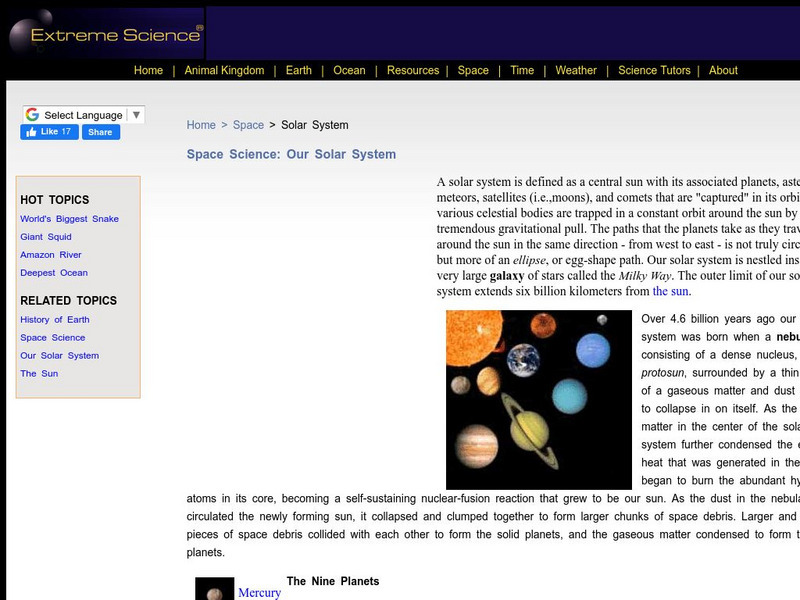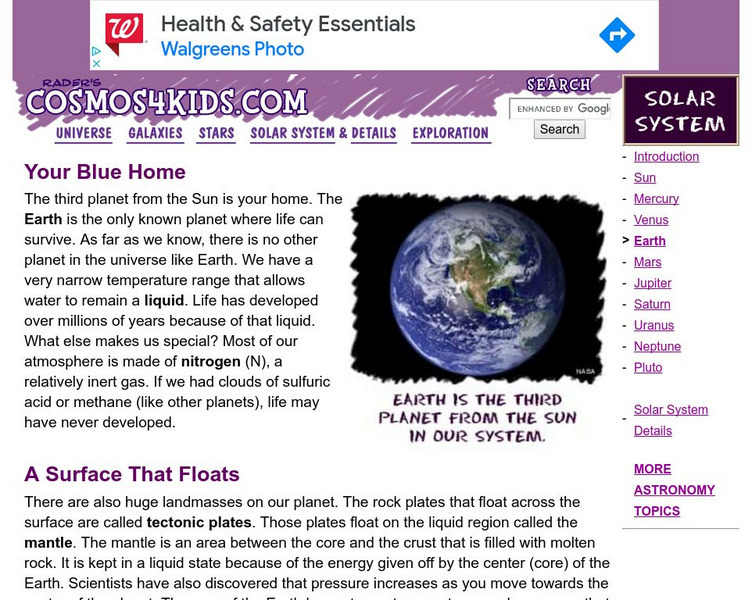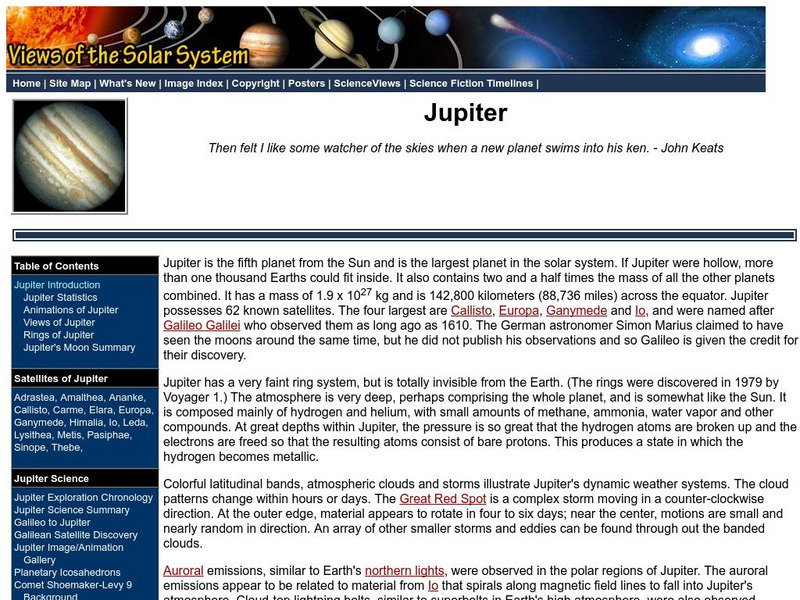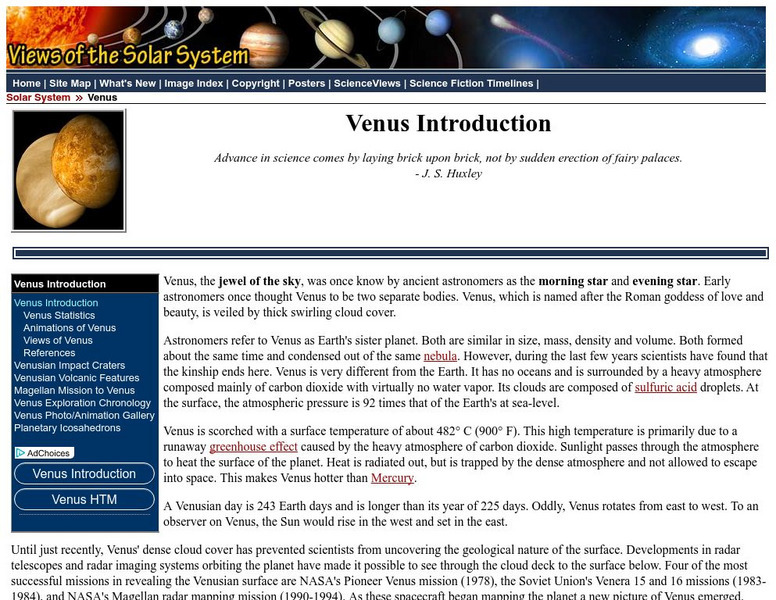Polk Brothers Foundation Center for Urban Education at DePaul University
De Paul University: Center for Urban Education: Learning About the Solar System [Pdf]
"Learning about the Solar System" is a one page, nonfiction, reading passage about the Milky Way gallaxy and how scientists learn about it over time. It is followed by questions which require students to provide evidence from the story;...
National Geographic
National Geographic: Extreme Weather on Other Planets
Examine the variety of weather found on all of the planets in the solar system with this classroom exercise. Students will see a video and observe differences and similarities among the planets.
Extreme Science
Extreme Science: Space Science: Our Solar System
Read about our solar system and its formation over 4.6 billion years ago. Find out about the planets, asteroids, meteors, satellites, and comets. More in-depth planet background can be accessed through links.
National Geographic
National Geographic: Planetary Size and Distance Comparison
Students review the sizes of planets and their order relative to the Sun. They then learn about astronomical uses and create a model of the solar system that reflects planetary distances. Includes handouts and worksheets as well as a...
Other
Lunar and Planetary Institute: Explore! Ice Worlds
Features a collection of hands-on activities, investigations, and explorations designed to engage students in learning about ice, both in the solar system and on planet Earth.
Cosmos 4 kids
Cosmos4 Kids: Solar System: Pluto
Learn all about Pluto ..its discovery, basic facts, recognition as a planet, and most recently, its 'demotion' from a planet to a dwarf planet. The brief, to the point text makes this site most suitable for younger researchers.
Alabama Learning Exchange
Alex: Inner and Outer Planets of the Solar System
For this science lesson learners will work collaboratively to learn and introduce the eight planets, sizes, characteristics, and their order. They will use size comparisons, research a planet, design a poster and create a PowerPoint...
Cosmos 4 kids
Cosmos4 Kids: Solar System: Earth
Learn the basic facts about planet Earth, and its unique position as the only known planet where life can survive. The brief, to the point text makes this site most suitable for younger researchers.
Views of the Solar System
Views of the Solar System: Mars
Discover interesting information about the planet Mars through a vast archive of photographs and scientific facts.
Views of the Solar System
Views of the Solar System: Neptune
Explore the planet Neptune through this site that includes vivid multimedia resources. Learn Neptune statistics and view numerous images.
Views of the Solar System
Views of the Solar System: Uranus
Explore the planet Uranus through this site that includes vivid multimedia resources. Learn Uranus statistics and view numerous images.
Views of the Solar System
Views of the Solar System: Saturn
Explore the planet Saturn through this site that includes vivid multimedia resources. Learn Saturn statistics and view numerous images.
Views of the Solar System
Views of the Solar System: Jupiter
Explore the planet Jupiter through this site that includes vivid multimedia resources. Learn Jupiter statistics and view numerous images.
Views of the Solar System
Views of the Solar System: Mercury
Discover interesting information about the planet Mercury through a vast archive of photographs and scientific facts.
Views of the Solar System
Views of the Solar System: Venus
Discover interesting information about the planet Venus through a vast archive of photographs and scientific facts.
Views of the Solar System
Views of the Solar System: Earth
Explore the planet Earth through this site that includes vivid multimedia resources. Learn Earth statistics and view numerous images.
Enchanted Learning
Enchanted Learning: The Planets
This survey of the planets includes all the basics, size, mass, atmosphere, length of day, and the like. It features interactive activities and learning exercises and compares all of the planets in colorful tables.
Science Education Resource Center at Carleton College
Serc: Planets Made Real: Creating Size and Distance Scale of Planets
An activity where students build a scale model of the solar system based on a marble they pick from a bowl. After choosing a marble that represents Earth, students must calculate the size of the other planets and the sun. Site includes...
Science Education Resource Center at Carleton College
Serc: Know Your Neighbors: Researching the Planets
Students will study planets and moons in our solar system by working online and other resources. This lesson has students working together to generate a spreadsheet of data found. Students will use this information to describe why Earth...
PBS
Pbs Learning Media: All Planet Sizes
This illustration from the Lunar and Planetary Laboratory shows the approximate sizes of the planets relative to each other. Note that the planets are not shown at appropriate distances from the Sun.
NASA
Nasa: What Is a Planet?
This lesson teaches students about the characteristics of planets, comets, asteroids, and trans-Neptunian objects. After learning about these different things, students then are to debate about a new object that is found in space.
NASA
Nasa: The Space Place: Planet X Treme Weather
Ever wonder what the weather is like on other planets besides Earth? This resource explores the extreme weather that occurs on other planets.
BBC
Bbc Schools: Ks2 Bitesize: Science: Physical Processes: Earth, Sun, and Moon
Help Sarah Jane and her team put the solar system's planets back in order. Following the activity, read more about the sun, the Earth, and its moon, and then take a quick quiz to check for understanding.
DOGO Media
Dogo News: Week of 10 21 13: Does It Rain Diamonds on Saturn and Jupiter?
Article reports on research that suggests that rain on Saturn and Jupiter may be made of diamonds. Includes a brief video.
![De Paul University: Center for Urban Education: Learning About the Solar System [Pdf] Unit Plan De Paul University: Center for Urban Education: Learning About the Solar System [Pdf] Unit Plan](https://static.lp.lexp.cloud/images/attachment_defaults/resource/large/FPO-knovation.png)



















